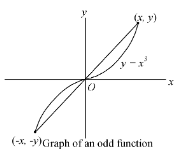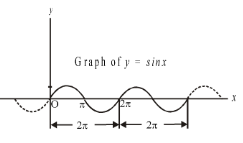Various type of function
Relation and function of Class 12
Various type of function
(a) Even and Odd Functions
A function y = f (x) is even if f (−x) = f (x) for every number x in the domain of f.
e.g. f (x) = x2 is even because f (−x) = (−x)2 = x2 = f (x).
A function y = f (x) is odd if f (−x) = −f (x) for every x in the domain of f.
e.g. f (x) = x3 is odd because f (−x) = −x3 = −f (x).
|
|
|
Note: (1) For Domain 'R', even functions are not one−one.
(2) Every function can be written as a sum of even and odd functions.
(3) f (x) = 0 is the only function which is both even and odd.
(4) Every odd continuous function passes through origin.
(5) The graph of an even function y = f (x) is symmetric about the y-axis. Equivalently
(x, y) lies on the graph ⇔ (−x, y) lies on the graph.
(6) The graph of an odd function y = f (x) is symmetric about origin. i.e. if point (x, y) is on the graph of an odd function, then (−x, −y) will also lie on the graph.
Application 5 Determine whether the function, f(x) =  is even, odd or neither of the two.
is even, odd or neither of the two.
Solution 
Hence the given function is even.
(b) Periodic FunctionA function f(x) is periodic if there is a positive number p such that f(x + p) = f(x) for all x ∈ D. The smallest value of such p is called the principal or fundamental period of f. If we draw graph of a periodic function f(x), we find graph gets repeated after each interval of length p. e.g. y = sin x is periodic with period 2π as sin(x + 2π) = sin x. Graphically |
|
Rules for finding period of a periodic function
(i) If f(x) is periodic with period p, then af(x) + b, where a, b ∈ R (a ≠ 0) is also a periodic function with period p.
(ii) If f(x) is periodic with period p, then f(ax + b), where a ∈ R\{0} and b ∈ R, is also periodic with period p/|a|.
(iii) If f(x) is periodic with p as the period and g(x) is periodic with q as the period
(p ≠ q) and L.C.M. of p & q is possible, then f(x) + g(x) is periodic with period equal to L.C.M. of p & q, provided f(x) and g(x) cannot be interchanged by adding a positive number in x which is less than L.C.M. of p & q in this case this number becomes period of f(x) + g(x).
(iv) If f(x) is periodic with period p, then I/f(x) is also periodic with same period p.
(v) If f(x) is periodic with period p,  also periodic with same period p.
also periodic with same period p.
(vi) If f(x) is a periodic function with period p and g(x) is a strictly monotonic function, then g(f(x)) will also be periodic with period p.
(vii) Constant function is periodic with no-fundamental period.
(c) Equal or Identical functions
Two functions 'f ' and 'g' are said to be equal iff they satisfy the following conditions:
(i) They have same domain.
(ii) They have same range.
(iii) f = g for all values of 'x' in their common domain.
e.g f (y) =  and g (x) =
and g (x) =  are equal functions.
are equal functions.
(d) Homogeneous function
A function with one or more than one independent variable and such that every term has the same degree is called as a homogeneous function.
e.g. f (x, y) = x2 − xy + 3y2 is a homogeneous function of degree '2'.
- Real Numbers
- Function
- Classification of Function
- Methods of finding whether function is One One or Many One
- Methods to find domain and rang of a function
- Various type of function
- Composition of functions
- Inverse of a function
- Exercise 1
- Exercise 2
- Exercise 3
- Exercise 4
- Exercise 5
- Exercise 6
- Exercise 7












